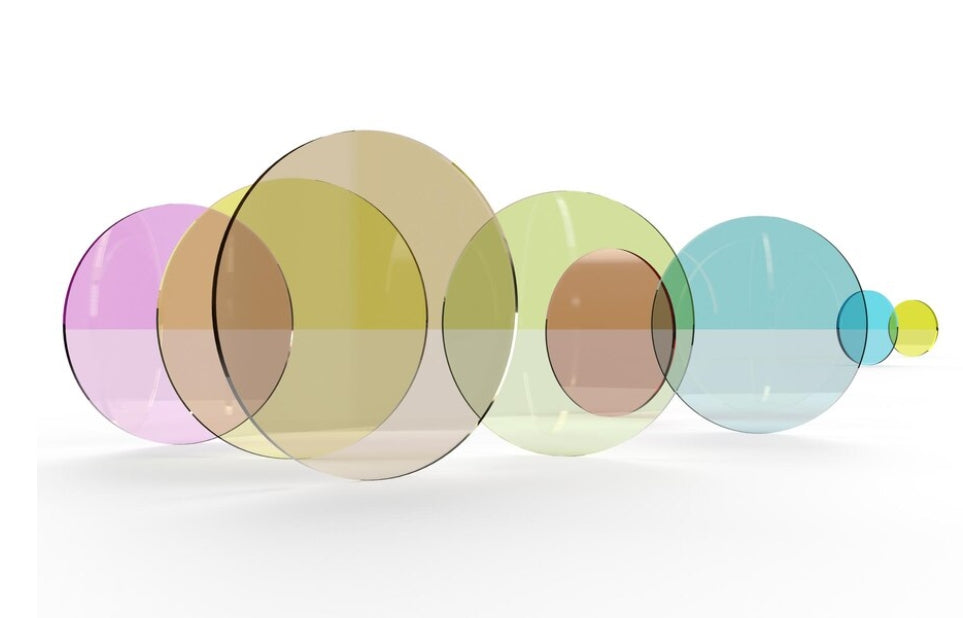Step into the world of sunglasses and unlock the secrets behind those tinted lenses. Have you ever wondered why some shades make everything look more vibrant while others provide a soothing, calming effect?
Step into the world of sunglasses and unlock the secrets behind those tinted lenses.
Have you ever wondered why some shades make everything look more vibrant while others provide a soothing, calming effect?
Prepare to delve deep into the captivating realm of different lens colors in sunglasses.
Come along as we unravel how different hues can have a mesmerizing impact on your vision - making life brighter, clearer, and even safer!

The Science Behind Different Lens Colors in Sunglasses
Light is made up of different wavelengths linked to different colors. Some colors are more visible and intense than others, depending on the light source and where you are.
Our eyes have special cells called cones that pick up these colors and send messages to our brains to process them into images.
Different lens colors in sunglasses work like filters that stop or let certain colors or wavelengths of light through. This can change how we see contrast, brightness, clarity, and color accuracy.
As an illustration, gray lenses reduce brightness without altering colors, whereas yellow lenses enhance contrast and visibility in low-light conditions.
One of the most important things about sunglasses' lenses is polarization.
What are polarized lenses, you ask?
These are lenses that incorporate a chemical film that nearly eliminates all reflected glare from horizontal surfaces.
Glare is the light that bounces off shiny horizontal surfaces like water, snow, wet pavement, or metal. Glare can make it hard to see, strain your eyes, and lead to accidents.
Polarized lenses eliminate glare and improve your vision by raising contrast, sharpness, and depth perception.
The Benefits and Drawbacks of Various Lens Colors in Sunglasses
As the natural light reacts differently to the various sunglasses lens tints, not all options work well in all situations.
So, consider what you’ll use it for before investing in a new pair.
Let’s take a quick look at what the different lens colors in sunglasses mean.
|
Lens Color |
Benefits |
Drawbacks |
Best for |
|---|---|---|---|
|
Gray |
Reduces overall brightness without changing colors |
May not provide enough contrast in low-light situations |
Driving, sunbathing, running, swimming |
|
Brown |
Enhances contrast and depth perception |
May change color perception highlighting brown |
Fishing, skiing, hunting |
|
Green |
Enhances clarity and contrast |
May not be suitable for very bright situations |
Golfing, fishing, driving in the rain |
|
Yellow |
Increases contrast and visibility in low-light situations |
May change color perception and cause glare when it’s bright |
Indoor sport, skiing, foggy days, low light conditions |
|
G15 gray/green |
Reduces glare and enhances color contrast |
Very comfortable tint for the human eye |
Water sports, snow sports, sunny days |
How to Choose the Best Lens Color for Your Sunglasses
Choosing the best lens color for your sunglasses depends on several factors. Your choice will be impacted by what you do outside, the typical lighting conditions, how much contrast, brightness, clarity, and color accuracy you want, and what you like. One sunglass tint will not improve visual performance in all levels of light or outdoor activity. Improve your visual performance and enjoyment of outdoor activities by having several lens tints in your sunglasses and then matching the tint to the situation.
Here are some tips on how to pick the best lens color for your sunglasses.
What will you mostly do while outside?
Think about what you do outside and how bright or dark it usually is where you are.
For example:
- If you like fishing or water sports, choose a lens color that reduces glare and improves contrast on water surfaces, such as green or brown.
- If you like skiing or snow sports, you might want to pick a lens color that makes contrast and visibility better on snow-covered ground, such as yellow or G15.
What is your desired vision quality?
Think about how much contrast, brightness, clarity, and color accuracy you want.
For example:
- If you want to see colors as they are without any change or difference, opt for a gray lens that filters light evenly. Gray would be the tint of choice for a photographer or outdoor artist as color accuracy is important.
- If you want to see more details and depth in your surroundings, choose a lens color optimizing contrast and depth perception, like brown or green.
Experiment!
Experiment with different lens colors in sunglasses to see how they affect your vision.
You can try on sunglasses with different lens colors and compare how they make you feel and see.
Also, ask for opinions from others or take photos of yourself wearing different sunglasses to see how they look on you.
Consult a professional
Consult an optometrist or an eye care professional if you have any specific eye health concerns or needs.
For example, if you have a vision impairment or a medical condition that affects your eyes, you might have to choose a lens tint providing more protection or correction for your eyes.
Also, ask for advice, recommendations, or prescriptions from your eye doctor.
Where to Get the Best Sunglasses with Colored Lenses?
Solar Bat is your best choice for performance polarized sunglasses with different lens colors.
Our sunglasses are high-quality and use the latest technology, made by an eye doctor with over 40 years of experience.
Whether you are looking for cool sunglasses, eye protection, or vision enhancement, Solar Bat has it all.
Best of all, before you check out your new pair, you can choose which color you want the lenses to be. So, you can shop for a perfect frame for your face.
Visit us today and find the best sunglasses for you!

